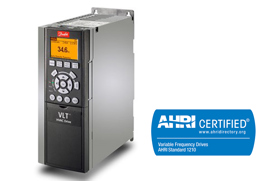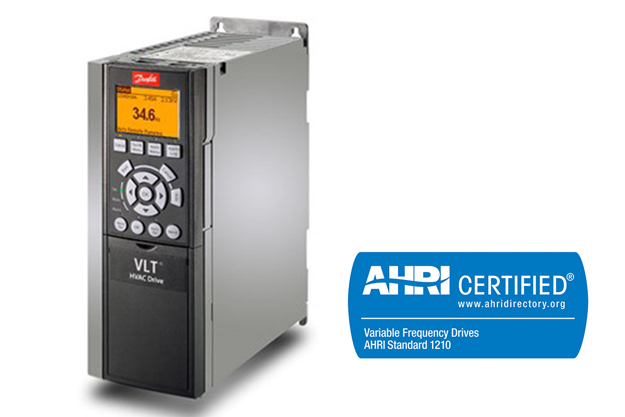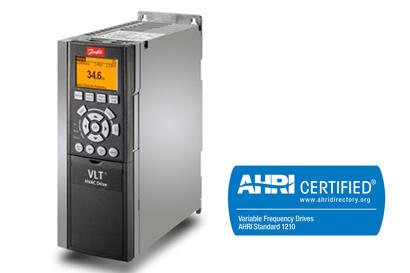Physicians and clinicians often need access to medical data in real time — just a few minutes of downtime is unacceptable. The data center industry has created standards to define the level of uptime required for a given class of application and the infrastructure needed to maintain that level. The standard being applied to medical data centers — known as the Uptime Institute’s Tier III standard — calls for 99.982 percent uptime, which translates to no more than 1.6 hours of downtime per year. This standard requires an uninterruptible power supply (UPS) system that can handle a power outage of at least 72 hours.
For the cooling system, the standard requires a level of redundancy so that the failure of any single computer room air-conditioning (CRAC) unit will go unnoticed by the end user — and that planned maintenance can occur without disrupting data center operations. That's why a data center manager for a medical center in the upper Midwest was pleased to discover that Danfoss variable frequency drives could not only cut energy consumption by 40 percent by controlling HVAC fan speed on CRAC units, but also can improve uptime by totally replacing the CRAC units’ built-in controls.
Data centers demand reliability and efficiency
In this Midwest healthcare data center application, cooling-system uptime reliability was assured by employing redundant CRAC units. For example, in a room needing eight units, ten were employed. According to the manager, "Under normal conditions, we're using 80 percent of the installed capacity to cool the room, which is about a 30 percent turndown.”
The CRAC units are positioned on the same raised floor occupied by the racks of computer servers. The units supply cool air into an underfloor plenum where it is distributed into cold aisles by perforated tiles. From there, the conditioned air is drawn into the computer rack inlets and ejected on the other side into hot aisles at a constant rate of flow. This design is simple and reliable, but maintaining a constant flow of air 24/7 does consume a lot of fan energy.
So when the facility recently initiated its 20-year equipment replacement process, the manager was looking for new technologies that would address energy efficiency concerns and would ensure that Tier III uptime standards could be met. An appraisal of the existing cooling system indicated the CRAC units were in good mechanical condition; the motors generally did not need replacement. Where replacement was needed, motors, bearings and valves were readily available. The parts for CRAC unit controls, however, were becoming scarce, and the existing panels did not meet the facility’s redundancy and plant operating goals.
Uncommonly smart drive intelligence replaces CRAC unit controls
When the data center manager contacted Brian Peterson of Schwab, Vollhaber and Lubratt, Inc., (SVL), Shoreview, Minn., near St. Paul., about automating a cooling tower using a Danfoss VLT® Drive, the manager discovered the drive also incorporated significant control capabilities that could be applied to CRAC units.
"Typically, Danfoss VLT® HVAC Drives are used to control fan motor speed to save energy in cooling applications," says Peterson. "In this application, the end user took advantage of the VLT® Drive's onboard intelligence to control the CRAC units themselves. As a result, we scrapped the control panels and keypads that came with the units. The VLT® Drives provided full, stand-alone unit control to improve reliability by handling electrical phase faults and compensate for CRAC unit failures.”
"The VLT® HVAC Drive has a tremendous amount of onboard intelligence," Peterson continues. "In this case, we could take advantage of that – along with a variable speed drive’s ability to cut energy consumption using fan affinity laws.”
In theory, the fan affinity law states that power is reduced in proportion to the cube of the fan's RPM, which means, for example, a 20 percent speed reduction translates into exponential fan energy savings. In this case, applying the drives enabled the data center to reduce its cooling costs by 40 percent.
Peterson notes that Danfoss factory support worked with him to develop the solution. “I was able to send and receive drive project files from Danfoss application support experts; the right people were in place to tailor the drive intelligence to the job’s requirements.”
One Danfoss variable frequency drive was installed at the bottom of each of 40 CRAC units. Each unit includes a VLT® Drive, a 7.5-hp fan motor, a chilled-water coil, and valve. The intelligence on each drive regulates the fan to maintain the proper air flow rate and underfloor duct static pressure. It also modulates the chilled water valve to control either discharge air temperature or return air temperature.
The intelligence on the FC102 drive provides floating point valve control. Unlike on/off control, the floating point controller responds to temperature rises above the set point by sending a signal to the actuator to open or close the chilled-water valve slowly to increase or decrease the coil temperature. When the set point plus dead band is reached, the actuator stops. The relative simplicity of this method of control is more reliable than proportional-integral-derivative (PID) control, where the valve is capable of moving continually.
Danfoss drives provide phase loss protection
Utilities supply data centers and industrial facilities with three-phase electrical power. But a downed power line, a blown fuse or equipment failure can cause the loss of one and even two phases – and reliable electric current is critical to data centers. “From an uptime/reliability point of view, a phase fault is one of the few things that can take out all motors in a data center,” says the manager. “Even if the phase fault doesn’t damage the motors, the resulting thermal overload can trip breakers, requiring local manual reset that can add up to serious downtime.”
However, Danfoss variable frequency drives provide motor protection with phase loss/imbalance detection that automatically compensates to continue operation on any two of the three input phases. The load is reduced when any input phase is lost. In that event, the reduced cooling capacity can be replaced by reserve capacity from the redundant CRAC units. These and other fault conditions can be monitored and controlled locally from the drive keypad — or though the Modbus TCP building automation system (BAS).
In this case, the BAS is used for monitoring and data collection only. To avoid the possibility of network failure inherent in a centralized control scheme, each CRAC unit is controlled locally. The OEM panel on each CRAC unit was replaced by the award-winning Danfoss backlit digital display and keyboard (password protected if required) with immediate access to motor power, motor voltage, motor nominal speed and minimum/maximum frequency.
Naturally, the data center manager uses the BAS to collect a lot of data on the performance of the drives and CRAC units. He notes that “when we discovered the capability of these drives, it was inevitable to put as much responsibility on the end controls rather than a centralized control. Essentially, the drives are doing the job of programmable logic controllers (PLCs) as well as a variable speed fan motor drive.”
The drive units have a remarkable maintenance and performance record. The data center manager continues: “In this facility, we have Danfoss drives that are more than ten years old, running 24/7 with zero failures to date. As for performance, incorporating the drives lets us reach our full energy savings potential. For redundancy, there is always significant excess capacity. Every unit is oversized by some margin. Then every redundant system is oversized again. For example, anywhere a data center needs three units, we install four or more. Taking advantage of this excess capacity and managing it with a drive allows for much more significant energy reductions than a typical HVAC application. It also allows the drive to run cooler, use fewer fan cycles and be more tolerant to utility faults.”
The outstanding Danfoss drive record comes as no surprise to Brian Peterson, who has been installing drives for over three decades. “The intelligence of Danfoss drives is incomparable to any other drive on the market. They’ve got the brains to handle CRAC unit control and the brawn to handle HVAC fan motors to meet uptime requirements – plus the energy efficiency to reduce a data center’s cooling costs.”
Get more information
-
if (isSmallPicture) {


 VLT® HVAC Drive FC 102
VLT® HVAC Drive FC 102This tough and savvy FC102 drive enhances pump and fan applications in building management systems, and runs outdoors in most climates.



